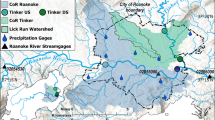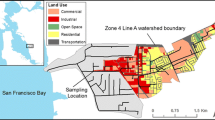Abstract
Background, aim, and scope
The City of Atlanta, Georgia (COA) is part of the ninth largest metropolitan area in the USA and one of the fastest growing (e.g., >24% between 2000 and 2007). Since 2003, the US Geological Survey has been operating an extensive long-term water-quantity and water-quality monitoring network for the COA. The experience gained in operating this network has provided insights into the challenges as well as some solutions associated with determining urban effects on water quality, especially in terms of estimating the annual fluxes of suspended sediment, trace/major elements, and nutrients.
Discussion and findings
The majority (>90%) of the annual fluxes of suspended sediment and discharge (>60%) from the COA occur in conjunction with stormflow. Typically, stormflow averages ≤20% of the year. Normally, annual flux calculations employ a daily time-step; however, due to the “flashy” nature of the COA’s streams, this approach can produce substantial underestimates (from 25% to 64%). Greater accuracy requires time-steps as short as every 2 to 3 h. The annual fluxes of ≥75% of trace elements (e.g., Cu, Pb, Zn), major elements (e.g., Fe, Al), and total P occur in association with suspended sediment; in turn, ≥90% of the transport of these constituents occurs in conjunction with stormflow. With the possible exception of nitrogen, baseflow sediment-associated and both baseflow and stormflow dissolved contributions represent relatively insignificant portions of the total annual load; hence, nonpoint (diffuse) sources are the dominant contributors to the fluxes of almost all of these constituents.









Similar content being viewed by others
References
Akan AO, Houghtalen RJ (2003) Urban hydrology, hydraulics, and stormwater quality. Wiley, Hoboken, p 373
Atlanta Regional Commission (2004) http://www.atlantaregional.com. Accessed on: July 22, 2004
Butler R (2003) World's largest urban areas ranked by urban area population. Accessed at: http://www.mongabay.com/cities_urban_01.htm. Accessed on: August 12, 2008
Christensen VG (2001) Characterization of surface-water quality based on real-time monitoring and regression analysis. Quivira National Wildlife Refuge, south-central Kansas, December 1998 through June 2001. U.S. Geological Survey Water-Resources Investigations 01-4248, 28pp
Clean Water Atlanta (2004) http://www.cleanwateratlanta.org. Accessed on: August 17, 2004
Clean Water Atlanta (2008) http://www.cleanwateratlanta.org. Accessed on: August 12, 2004
Coynel A, Schafer J, Hurtrez J-E, Dumas J, Etcheber H, Blanc G (2004) Sampling frequency and accuracy of SPM flux estimates in two contrasted drainage basins. Sci Total Environ 330:233–247
Driver NE, Troutman BM (1989) Regression models for estimating urban storm-runoff quality and quantity in the United States. J Hydrol 109:221–236
Edwards TK, Glysson GD (1999) Field methods for measurement of fluvial sediment. U. S. Geological Survey Technique of Water-Resource Investigation, Book 3, Chapter C2: 118 pp
Ellis JB (1979) The nature and sources of urban sediments and their relation to water quality: a case study from north-west London. In: Hollis GE (ed) Man’s impact on the hydrological cycle in the United Kingdom. Geo Books, Norwich, pp 199–216
Ellis JB (ed) (1999) Impacts of urban growth on surface water and groundwater quality. IAHS Publication No. 259, 437 pp
Frick EA, Hippe DJ, Buell GR, Couch CA, Hopkins EH, Wangsness DJ, Garrett JW (1998) Water quality in the Apalachicola-Chattahoochee-Flint river basin: Georgia, Alabama, and Florida, 1992–1995, U.S. Geological Survey Circular 1164, Reston, V
Goodwin TH, Young AR, Mathew GRH, Old GH, Hewitt N, Leeks GJL, Packman JC, Smith BPG (2003) The temporal and spatial variability of sediment transport and yields within the Bradford Beck catchment, West Yorkshire. Sci Total Environ 314–316:475–494
Goolsby DA, Battaglin WA, Aulenbach BT, Hooper RP (2001) Nitrogen input to the Gulf of Mexico. J Environ Qual 30:329–336
Horowitz AJ (1995) The use of suspended sediment and associated trace elements in water quality studies. IAHS Special Publication No. 4, IAHS Press, Wallingford, UK; 58 pp
Horowitz AJ (2003) An evaluation of sediment rating curves for estimating suspended sediment concentrations for subsequent flux calculations. Hydrol Process 17:3387–3409
Horowitz AJ (2006) The effect of the ‘Great Flood of 1993’ on subsequent suspended sediment concentrations and fluxes in the Mississippi River Basin, USA. In: Rowan JS, Duck RW, Werrity A (eds) Sediment dynamics and the hydromorphology of fluvial systems. IAHS, Wallingford, pp 110–119 2006 IAHS Publication No. 306
Horowitz AJ (2008) Determining annual suspended sediment and sediment-associated trace element and nutrient gluxes. Sci Total Environ 400:315–343
Horowitz AJ, Hughes WB (2006) The U.S. Geological Survey and City of Atlanta Water-Quality and Water-Quantity Monitoring Network, U.S. Geological Survey Fact Sheet 2005-3126, USGS, Atlanta, GA, USA, 4 pp
Horowitz AJ, Stephens VC (2008) The effects of land use on fluvial sediment chemistry for the conterminous U.S.—results from the first cycle of the NAWQA Program: trace and major elements, phosphorus, carbon, and sulfur. Sci Total Environ 400:290–314
Horowitz AJ, Elrick KA, Hooper RC (1989) A comparison of instrumental dewatering methods for the separation and concentration of suspended sediment for subsequent trace element analysis. Hydrol Process 2:163–184
Horowitz AJ, Elrick KA, Smith JJ (2001a) Estimating suspended sediment and trace element fluxes in large river basins: methodological considerations as applied to the NASQAN program. Hydrol Process 15:1107–1132
Horowitz AJ, Elrick KA, Smith JJ (2001b) Annual suspended sediment and trace element fluxes in the Mississippi, Columbia, Colorado, and Rio Grande drainage basins. Hydrol Process 15:1169–1207
Horowitz AJ, Elrick KA, Smith JJ (2008) Monitoring urban impacts on suspended sediment, trace element, and nutrient fluxes within the City of Atlanta, Georgia, USA: program design, methodological considerations, and initial results. Hydrol Process 22:1473–1496
Horowitz AJ, Elrick KA, Demas CR, Demcheck DK (1991) The use of sediment-trace element geochemical models for the identification of local fluvial baseline concentrations. In: Peters NE, Walling DE (eds) Sediment and stream water quality in a changing environment: trends and explanation, IAHS Publication 203. IAHS, Wallingford, pp 339–348
Horowitz AJ, Meybeck M, Idlafkih Z, Biger E (1999) Variations in trace element geochemistry in the Seine River Basin based on floodplain deposits and bed sediments. Hydrol Process 13:1329–1340
Keyes AM, Radcliffe DA (2002) Protocol for establishing sediment TMDLs. The Georgia Conservancy, Georgia 31
Larsen T, Broch K, Andersen MR (1999) First flush effects in urban catchment area in Aalborg. Water Sci Technol 37:251–257
Lawler DM, Petts GE, Foster IDL, Harper S (2006) Turbidity dynamics during spring storm events in an urban headwater river system: The Upper Tame, West Midlands, UK. Sci Total Environ 360:109–126
Lee JH, Bang KW, Ketchum LH, Choe JS, Yu MJ (2002) First flush analysis or urban storm runoff. Sci Total Environ 293:163–175
Leeks GJL, Jones TP, Hollingworth NT (2006) Forward: an introduction to UK research on the urban environment. Sci Total Environ 360:1–4
Meybeck M, Horowitz AJ, Grosbois CA (2004) The geochemistry of Seine River Basin particulate matter: distribution of an integrated metal pollution index. Sci Total Environ 328:219–236
Minella JPG, Merten GH, Reichert JM, Clarke RT (2008) Estimating suspended sediment concentrations from turbidity measurements and the calibration problem. Hydrol Process 22:1819–1830
National Climate Data Center (2006) http://www.ncdc.noaa.gov/oa/ncdc.html. Accessed on: August 15, 2006
Old GH, Leeks GJL, Packman JC, Smith BPG, Lewis S, Hewitt EJ, Holmes M, Young A (2003) The impact of a convectional summer rainfall event on river flow and fine sediment transport in a highly urbanized catchment: Bradford, West Yorkshire. Sci Total Environ 314/316:495–512
Old GH, Leeks GJL, Packman JC, Smith BPG, Lewis S, Hewitt EJ (2006) River flow and associated transport of sediments and solutes through a highly urbanised catchment, Bradford, West Yorkshire. Sci Total Environ 360:98–108
Old GH, Leeks GJL, Packman JC, Stokes N, Williams ND, Smith BPG, Hewitt EJ, Lewis S (2007) Dynamics of sediment-associated metals in a highly urbanised catchment: Bradford, West Yorkshire. J Chartered Inst Water Environ Manag 18:11–16
Owens PN, Walling DE (2002) The phosphorus content of fluvial sediment in rural and industrialized river basins. Water Res 36:685–701
Peters NE, Kandell SJ (1999) Evaluation of stream water quality in Atlanta, Georgia and the surrounding region. In: Ellis JB (ed) Impacts of urban growth on surface water and groundwater quality. IAHS, Wallingford, pp 279–290 IAHS Publication No. 259
Porterfield G (1977) Computation of fluvial-sediment discharge. Techniques of Water-Resources Investigations of the U.S. Geological Survey, Chapter C3, Book 3: 66 pp
Rasmussen TJ, Ziegler AC, Rasmussen PP (2005) Estimation of constituent concentrations, densities, loads, and yields in lower Kansas River, northeast Kansas, using regression models and continuous water-quality monitoring, January 2000 through December 2003. U.S. Geological Survey Scientific Investigations Report 2005-5165, Lawrence, Kansas, 126 pp
Rasmussen TJ, Lee CJ, Ziegler AC (2008) Estimation of constituent concentrations, loads, and yields in streams of Johnson County, northeast Kansas, using continuous water-quality monitoring and regression models, October 2002 through December 2006. U.S. Geological Survey Scientific Investigations Report 2008-5014, Lawrence, KS, 104 pp
Rose S, Peters NE (2001) Effects of urbanization on streamflow in the Atlanta area (Georgia, USA): a comparative hydrological approach. Hydrol Process 15:1441–1457
Shepherd KA, Ellis PA, Rivett MO (2006) Integrated understanding of urban land, groundwater, baseflow and surface-water quality—The City of Birmingham, UK. Sci Total Environ 360:180–195
Stelzer RS, Likens GE (2006) Effects of sampling frequency on estimates of dissolved silica export by streams: the role of hydrological variability and concentration-discharge relationships. Water Resour Res 42:7415–7424
Syvitski JPM, Vorosmarty CJ, Kettner AJ, Green P (2005) Impact of humans on the flux of terrestrial sediment to the global coastal ocean. Science 308:376–380
Thomas A, Tellam J (2006) Modelling of recharge and pollutant fluxes to urban groundwaters. Sci Total Environ 360:158–179
United Nations Development Program (2005) Human Development Report, 2005. Oxford University Press, Oxford, UK, pp 232–235
United States Geological Survey. Various. National field manual for the collection of, water-quality data. Techniques of Water-Resources Investigations of the U.S. Geological Survey, Chapters A1–A9, Book 9. U.S. Government Printing Office, Washington, DC
Vanni MJ, Renwick WH, Headworth JL, Auch J, Schaus MH (2001) Dissolved and particulate nutrient flux from three adjacent agricultural watersheds: a five-year study. Biogeochem 54:85–114
Walling DE, Webb BW (1981) The reliability of suspended sediment load data. In: Erosion and sediment transport measurement. IAHS, Wallingford, pp 177–194, IAHS Publication No. 133
Walling DE, Webb BW (1988) The reliability of rating curve estimates of suspended sediment yield: some further comments. In: Bordas MP, Walling DE (eds) Sediment budgets. IAHS, Wallingford, pp 337–350 IAHS Publication No. 174
Wikipedia (2008) http://en.wikipedia.org/wiki/List_of_United_States_metropolitan_areas. Accessed on: August 12, 2008
Wong CS, Xiangdong L, Thornton I (2006) Urban environmental geochemistry of trace metals. Environ Pollut 142:1–16
World Urbanization Prospects (2006) http://esa.un.org/unup/. Accessed on: August 8, 2006
Author information
Authors and Affiliations
Corresponding author
Additional information
Responsible editors: Kevin G. Taylor and Philip N. Owens
Rights and permissions
About this article
Cite this article
Horowitz, A.J. Monitoring suspended sediments and associated chemical constituents in urban environments: lessons from the city of Atlanta, Georgia, USA Water Quality Monitoring Program. J Soils Sediments 9, 342–363 (2009). https://doi.org/10.1007/s11368-009-0092-y
Received:
Accepted:
Published:
Issue Date:
DOI: https://doi.org/10.1007/s11368-009-0092-y




